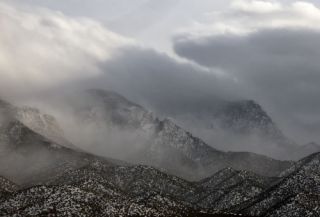Originally published on Celebrating New Mexico Statehood, 8/1/2018
The sun is out, but the air is cold, very cold. The Hillerman Project team of graduate fellows is back to work after a long and satisfying winter break. The Sandia Mountains, visible from just about every corner in Albuquerque, have strings, ropes, and knots of white draped all over them. The temperatures at night drop well below freezing point, and a persistent layer of frost sticks to the windshield in the morning. To many who are not familiar with the dramatic weather elements of New Mexico, the “land of enchantment” evokes images of desert landscapes, scorching heat, and tumbleweeds rolling across the road in the dry, dusty wind. And yes, all that is true, but for only a portion of the year. A few significant facts about New Mexico:
- Mountains make up 40% of its terrain, with many peaks (including our Sandias) rising above 10,000 feet (that’s 3,048 meters).
- Despite having become a symbol of the Western frontiers, Tumbleweed, whose official name is Russian thistle, is not native to the American Southwest. It is, in fact, an invasive species imported accidentally along with grain seeds transported by Ukrainian farmers to North America in the late 1800s.
- It has four, fairly distinct seasons, characterized by mountain snow in winter, ferocious winds in spring, monsoon rains in summer, and, finally, a mild, lingering, beautiful autumn. And yes, we have trees that change colors.
Hillerman’s novels make use of New Mexico’s pronounced seasonal changes and incorporate them into the scenic descriptions that contribute greatly to the sense of mystery that is embedded in the landscape. Man, in Hillerman’s works, is always relatively small, placed within wild and vast natural (and occasionally dominating urban) locations and at the mercy of unpredictable meteorological forces. Such forces often coincide with or augment the suspense as well as the suggestive airs of the supernatural conjured by the mystery’s plot. And so in Dancehall of the Dead, the winter solstice Shalako ceremonies of the Zuni people are obscure, exclusive, and cryptic, and are accordingly engulfed by the long, dark nights of December, and the snow on the ground that accentuates—or covers over--moccasin footprints and blood stains alike.
Similarly, In People of Darkness, the intense winter weather accompanies Jim Chee’s investigation of serial killings on the Navajo Reservation. In a particularly memorable scene, Chee and his new girlfriend, Mary Landon, are stranded in a remote part of the reservation, and must spend the night hiding in a creepy burial hole. It is a night of a typical snow blizzard in the high desert, and they have nothing but the clothes on their backs and a dead man’s bones to keep them warm. Of course Hillerman’s other novels, set in spring or summer, are equally as thrilling, but this scene has a different flavor than the soft summer evenings of The Dark Wind, in which Chee spreads out his bedroll under a star-studded sky and tucks his shoulder into the warm sand. Just the thought of a January night out in the caves and the blowholes of Navajo Country brings a chill to the spine that adds a visceral effect to the “chilling” intrigue of a good mystery.

